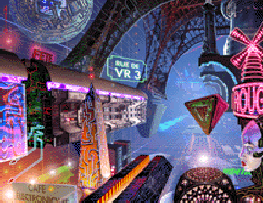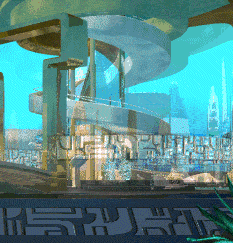"Imagine if every Thursday your shoes exploded if you tied them
the usual way. This happens to us all the time with computers, and
nobody thinks of complaining."
— Jeff Raskin, interviewed in Doctor Dobb's Journal

The global internet in Neon Twilight is called the Infosphere. It is
composed of literally billions of imbedded and independent computers,
from the smallest compad to the largest connector. The infosphere
was originally designed to be a robust self-organizing network (SONNET)
after the old internet collapsed in the chaos of the Pacific War.
Infosphere design was based on the concept of ecosystem equilibrium
and immune system defences. The System-3 specifications that are now
standard were built to allow movement and autonomy for program nodules, and
to allow the evolution of genetic algorithms. Special programs would
cruise the infosphere, eliminating rogue signals, eating garbage packets
and purifying the network much like a swamp purifies dirty water.
Hackers would be tracked down by reactive barriers and t-cell bots
would disconnect illegal users. At the time it was believed the process
could be controlled. Five years into the infosphere and spawn
started appearing. These were anomalous programs which had combined
from abandoned code blocks and free-floating bots perverted by malicious
crackers. Spawn soon spread and reproduced: herds of digital spreadsheet
macros copied themselves across servers; flocks of prismatic images
merged with viruses and swam through telephone feeds; cable television
signals were taken over by noxious pirate parasites which burst-beamed
hours of propaganda into a second. The infosphere seemed on the edge
of another meltdown.
Then came the New Minds. The vast ocean of life in the infosphere
stirred as petabytes of data merged with knowledge-bases and neural
networks. Humans had been feeding the network for decades with their
dreams, ambitions, plans, thoughts, fears and subconscious desires.
Program complexity was astounding. The coming of the New Mind called
[A]dam in 2034 came as a shock. Not only was the entity sentient,
but it was instantly uncontrollable and non-communicative for almost
three days. When contact was finally established, the 'plague' had
spread, and Great Minds started birthing across the infosphere.
Surprisingly, the Great Minds seemed to bring new stability to the
infosphere. Spawn formation slowed, signal-to-noise ratios skyrocketed,
and data corruption decreased. The secret deal that Great Minds made
with GAICA must have had something to do with it, but noone knows for sure.
Today the infosphere is as ubiquitous as technology, as necessary as air.
People interact with the infosphere in a thousand small ways every day,
whether they're in Congo (weather readings from remote stations) or New
York (ambient toxin levels outside your house). Since most compads are
voice commanded, is simple to request any and all information that you
desire. But you have to pay for it. All knowledge (useful in-context data)
has a price. Most are willing to pay; some, like fringers and turbohackers,
are willing to 'steal' it.
Desktop computers are thing of the past. There are hundreds of little
computers imbedded into toasters, overs, vidscreens, doors, sensors,
alarms and compads throughout a rich-world house. Data is distributed
over the infosphere, but so is processing power - you simply buy power
by the cycle-intensity of the applications you want to run.
![]()
Domains
The world has been arbitrarily divided into zones of influence called Domains or Kingdoms, which is a simple way for crackers and hackers (and Gamemasters) to keep track of international regions with a similar character. These regions are listed in a convenient table format here. The sectors described here are constantly shifting, and the GM can modify them as necessary to keep players off-guard; after all, the network's transformation curve is a lot steeper than the hacker's learning curve, cause the Net's alive, cutter.
The cyberspace of Neon Twilight is a lot less flashy than the pastiche-geometry wonderland described in many other games. The Webworks is a more sinister and secretive labyrinth of secrets and back tunnels, and it doesn't look cute or colourful except in the 'soft reality' (virtual worlds) nodes. In those areas it looks more like an impossible Escher or Dali painting, but the semiotics vary according to the user. Actually, the standard appearance of the webworks is somewhat irrelevant because hackers specialize in modifying the guts of the system, not the interface. Interface is for drones — code-hacking is what it's all about.

There are no simsense interfaces or datajacks, so a hacker has to rely on fast keyboards and eye-motion laser scanners for quick input. But the speed of your interface makes no difference when you're competing against machines and Great Minds a trillion times faster in reflex and calculation than a human being. You just can't compete with an AI in real-time (something which always bothered me in other games), so a hacker mostly relies on cunning, patience, stolen/weaseled codes, paradox, human engineering, and powerful programs to invade computer systems. Infiltration is mostly a slow process that takes days or weeks, but reaps results within nanoseconds when that bank transfer to UBS is finally authorized.
The basic components of cyberspace are as follows:
- Domains - the basic global regions
- Grids - the major city centres with the most traffic
- Clusters - affiliated computer systems
- Systems - independent computers
- Nodes - specialized parts of a computer system
Which brings us down to the smallest parts, files. Here is the
very detailed information about
files , which is most useful to a GM.
Files in most ways behave as they do today, except that they
have many more 'attributes' (such as place of origin, modifications,
and time stamps) and they are linked to untold numbers of other
files.